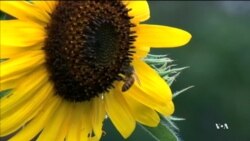While the collapse of honey bee colonies in North America is still an unsolved mystery, a biologist with the U.S. Geological Survey is trying to preserve the memory of thousands of varieties of pollinating insects, some of which may become extinct.
A mysterious phenomenon known as Colony Collapse Disorder is devastating honeybee populations all over the world. Conservationists say some of North America's 4,000 bee species could be wiped out.
Rutgers University researcher Rachael Winfree said honeybees are not the only pollinators in danger. “What we found is that the native wild insects are doing about a half of the flower visitation,” she said.
A scientist with the U.S. Geological Survey, Sam Droege, said bees are too beautiful to be forgotten if they vanish forever. So, with the help of a lab technician, he is making full color portraits of them.
“When you look at our native species, you are talking metallic colors, metallic greens, blues, blacks with heavy pitting, some are highly armored, some are red,” he said.
Droege is photographing not only the domesticated honeybees, but also many of the wild species that pollinate crops.
He collects some of the specimens himself, while others are sent to him by government agencies, researchers and institutions across the country.
Before their photo session, the bees must be washed and dried. Droege positions them in a special white box that bounces the light, leaving no shadows.
The photographs, taken from multiple angles, are merged by a computer program into a single beautiful picture.
Droege said his work has two components. “One component is simply scientific, so that it illustrates our identification guide, which are very technical and can only be seen by a small number of people. But the other aspect is sort of a vehicle for talking and illustrating all the beauty.”
Droege said the detailed photos will help researchers by saving them time and preventing identification errors.
Some of the pictures are available at the U.S. Geological Survey website.
A mysterious phenomenon known as Colony Collapse Disorder is devastating honeybee populations all over the world. Conservationists say some of North America's 4,000 bee species could be wiped out.
Rutgers University researcher Rachael Winfree said honeybees are not the only pollinators in danger. “What we found is that the native wild insects are doing about a half of the flower visitation,” she said.
A scientist with the U.S. Geological Survey, Sam Droege, said bees are too beautiful to be forgotten if they vanish forever. So, with the help of a lab technician, he is making full color portraits of them.
“When you look at our native species, you are talking metallic colors, metallic greens, blues, blacks with heavy pitting, some are highly armored, some are red,” he said.
Droege is photographing not only the domesticated honeybees, but also many of the wild species that pollinate crops.
He collects some of the specimens himself, while others are sent to him by government agencies, researchers and institutions across the country.
Before their photo session, the bees must be washed and dried. Droege positions them in a special white box that bounces the light, leaving no shadows.
The photographs, taken from multiple angles, are merged by a computer program into a single beautiful picture.
Droege said his work has two components. “One component is simply scientific, so that it illustrates our identification guide, which are very technical and can only be seen by a small number of people. But the other aspect is sort of a vehicle for talking and illustrating all the beauty.”
Droege said the detailed photos will help researchers by saving them time and preventing identification errors.
Some of the pictures are available at the U.S. Geological Survey website.









